
Royal Standard of Spain
Encyclopedia

- For other monarchs' standards, see Royal StandardRoyal StandardThe Royal Standard of the United Kingdom is the flag used by Elizabeth II in her capacity as Sovereign of the United Kingdom and its overseas territories...
.
The Royal Standard of Spain (Estandarte Real or Estandarte del Rey) is the official flag of the King of Spain. The present design is regulated by Title II, Rule 2, of Spanish Royal Decree 1511 of 21 January, 1977, whereby the Rules for Flags, Standards, Guidons, Banners and Badges are adopted.
The Royal Standard of Spain consists of a dark blue square with the coat of arms of the King
Coat of arms of the King of Spain
The blazoning of the coat of arms of the King of Spain is set out in Title II, Rule 1, of Spanish Royal Decree 1511 of 21 January 1977, by which the Rules for Flags, Standards, Guidons, Banners, and Badges were adopted.- Quartered shield :...
in the center. It is usually hoisted at the King's official residence, the Palacio de la Zarzuela
Palacio de la Zarzuela
Zarzuela Palace is the principal residence of King Juan Carlos of Spain and Queen Sofia and their family. The palace is on the outskirts of Madrid, near the Royal Palace of El Pardo. The complex also houses the official residence of the Prince and Princess of Asturias in a nearby mansion...
.
The Royal Guidon
The Royal GuidonColours, standards and guidons
In military organizations, the practice of carrying colours, standards or Guidons, both to act as a rallying point for troops and to mark the location of the commander, is thought to have originated in Ancient Egypt some 5,000 years ago...
(Guión) is regulated by Title II, Rule 1, of Royal Decree 1511/1977. It is identical to the Royal Standard except that the Royal Guidon has a golden fringe around it. It is made of silk
Silk
Silk is a natural protein fiber, some forms of which can be woven into textiles. The best-known type of silk is obtained from the cocoons of the larvae of the mulberry silkworm Bombyx mori reared in captivity...
’s taffeta. The size of the guidon is 80 x 80 cm. It is the personal command sign or positional flag of the monarch and carried nearby him.
The Standard and the Guidon of the Prince of Asturias

Prince of Asturias
Prince of Asturias is the historical title given to the heir to the Spanish throne. It was also the title under the earlier Kingdom of Castile. The current Prince of Asturias is Felipe, son of King Juan Carlos of Spain and Queen Sofía...
(Estandarte del Príncipe de Asturias) is regulated by Royal Decree 284/2001 that modified the Title II of Spanish Royal Decree 1511/1977.
The Standard of the Prince consists of a light blue (the colour of the Flag of Asturias
Flag of Asturias
250px|thumb|right|Flag of AsturiasThe flag of Asturias shows the "Cruz de la Victoria" in gold over blue ....
) square flag with the Coat of arms of the Prince of Asturias
Coat of arms of the Prince of Asturias
The blazon of the coat of arms of the Prince of Asturias appears in Royal Decree 284 of 16 March 2001, whereby His Guidon and His Standard are created.QUARTERED SHIELD:...
in the center.
The Guidon (Guión) is identical to the Standard except that the Royal Guidon has a golden fringe. It is made of silk’s taffeta. The size of the guindon is 80 x 80 cm.
Historical standards, guidons and banners of arms of Spanish monarchs
- The Banner of Arms was the ceremonial ensign of the monarch, the Royal Standard or Royal Flag was the ensign for a common use.
- From Philip IIPhilip II of SpainPhilip II was King of Spain, Portugal, Naples, Sicily, and, while married to Mary I, King of England and Ireland. He was lord of the Seventeen Provinces from 1556 until 1581, holding various titles for the individual territories such as duke or count....
reign the Royal Guidon was identical to the Royal Standard or Royal Flag with the Cross of BurgundyCross of Burgundy FlagThe Cross of Burgundy flag was used by Spain 1506-1701 as a naval ensign, and up to 1843 as the land battle flag, and still appears on regimental colours, badges, shoulder patches and company guidons...
and a Gold fringe.
| The Banners of Arms Heraldic flag In heraldry and vexillology, an heraldic flag is any of several types of flags, containing coats of arms, heraldic badges, or other devices, used for personal identification.... |
||
| Banner of Arms | Dates | Details |
|---|---|---|
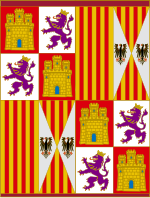  |
1475 - 1506 | The banner of arms of the Catholic Monarchs Catholic Monarchs The Catholic Monarchs is the collective title used in history for Queen Isabella I of Castile and King Ferdinand II of Aragon. They were both from the House of Trastámara and were second cousins, being both descended from John I of Castile; they were given a papal dispensation to deal with... , Isabella I of Castile Isabella I of Castile Isabella I was Queen of Castile and León. She and her husband Ferdinand II of Aragon brought stability to both kingdoms that became the basis for the unification of Spain. Later the two laid the foundations for the political unification of Spain under their grandson, Charles V, Holy Roman Emperor... and Ferdinand II of Aragon Ferdinand II of Aragon Ferdinand the Catholic was King of Aragon , Sicily , Naples , Valencia, Sardinia, and Navarre, Count of Barcelona, jure uxoris King of Castile and then regent of that country also from 1508 to his death, in the name of... , whose marriage unified Spain Spain Spain , officially the Kingdom of Spain languages]] under the European Charter for Regional or Minority Languages. In each of these, Spain's official name is as follows:;;;;;;), is a country and member state of the European Union located in southwestern Europe on the Iberian Peninsula... , were on a crimson background: Quarterly, 1 and 4. quarterly Castile-Leon, 2 and 3. per pale Aragon and Argon-Sicily. In 1492 the conquest of Granada was symbolized by the addition enté en point of a quarter for Granada. The banner of arms was also used as the Catholic Monarchs Catholic Monarchs The Catholic Monarchs is the collective title used in history for Queen Isabella I of Castile and King Ferdinand II of Aragon. They were both from the House of Trastámara and were second cousins, being both descended from John I of Castile; they were given a papal dispensation to deal with... ' Infantry Infantry Infantrymen are soldiers who are specifically trained for the role of fighting on foot to engage the enemy face to face and have historically borne the brunt of the casualties of combat in wars. As the oldest branch of combat arms, they are the backbone of armies... ensign. |
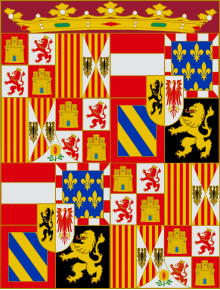 |
1518 - 1556 | In 1504, Archduke Philip the Handsome Philip I of Castile Philip I , known as Philip the Handsome or the Fair, was the first Habsburg King of Castile... (King of Castile and Leon by marriage with Joanna Joanna of Castile Joanna , nicknamed Joanna the Mad , was the first queen regnant to reign over both the Crown of Castile and the Crown of Aragon , a union which evolved into modern Spain... ) immediately staked his claim to her inheritance by quartering his own arms with those of the Catholic Monarchs, the Spanish quarters were given precedence over his. Hence the arrangement became, quarterly: 1. and 4. grand quarters, quarterly: A. and D. quarterly Castile-Leon, B. and C. per pale Aragon-Sicily, the grand quarter enté en point for Granada; 2. and 3. grand quarters, quarterly Austria, Burgundy ancient, Burgundy modern, Brabant, with an escutcheon per pale Flanders and Tyrol. In 1518 their son Charles I of Spain Charles V, Holy Roman Emperor Charles V was ruler of the Holy Roman Empire from 1519 and, as Charles I, of the Spanish Empire from 1516 until his voluntary retirement and abdication in favor of his younger brother Ferdinand I and his son Philip II in 1556.As... (Charles V as Holy Roman Emperor Holy Roman Emperor The Holy Roman Emperor is a term used by historians to denote a medieval ruler who, as German King, had also received the title of "Emperor of the Romans" from the Pope... ) adopted a banner of arms that comprised these arms on a crimson background. The arms were crowned with the old royal crown (an open crown). After his election as Holy Roman Emperor in 1519 Charles used more often the imperial banner: A shield with his own arms surmounting a black double-headed eagle on a golden background. |
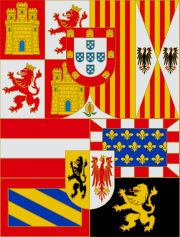 |
1580 - 1668 | During the reign of King Phillip II Philip II of Spain Philip II was King of Spain, Portugal, Naples, Sicily, and, while married to Mary I, King of England and Ireland. He was lord of the Seventeen Provinces from 1556 until 1581, holding various titles for the individual territories such as duke or count.... the arms of the Spanish Monarchy become fixed for the remainder of the House of Austria. Originally Philip II used the simplified arms as devised for his father, namely per fess with the Spanish quarters in chief and the Austrian quarters in base. After the dynastic union Iberian Union The Iberian union was a political unit that governed all of the Iberian Peninsula south of the Pyrenees from 1580–1640, through a dynastic union between the monarchies of Portugal and Spain after the War of the Portuguese Succession... with Portugal Portugal Portugal , officially the Portuguese Republic is a country situated in southwestern Europe on the Iberian Peninsula. Portugal is the westernmost country of Europe, and is bordered by the Atlantic Ocean to the West and South and by Spain to the North and East. The Atlantic archipelagos of the... in 1580, the arms of the Monarchy became per fess, in chief per pale, A. quarterly Castile Kingdom of Castile Kingdom of Castile was one of the medieval kingdoms of the Iberian Peninsula. It emerged as a political autonomous entity in the 9th century. It was called County of Castile and was held in vassalage from the Kingdom of León. Its name comes from the host of castles constructed in the region... and Leon Kingdom of León The Kingdom of León was an independent kingdom situated in the northwest region of the Iberian Peninsula. It was founded in AD 910 when the Christian princes of Asturias along the northern coast of the peninsula shifted their capital from Oviedo to the city of León... , B. per pale Aragon Aragon Aragon is a modern autonomous community in Spain, coextensive with the medieval Kingdom of Aragon. Located in northeastern Spain, the Aragonese autonomous community comprises three provinces : Huesca, Zaragoza, and Teruel. Its capital is Zaragoza... and Aragon-Sicily Sicily Sicily is a region of Italy, and is the largest island in the Mediterranean Sea. Along with the surrounding minor islands, it constitutes an autonomous region of Italy, the Regione Autonoma Siciliana Sicily has a rich and unique culture, especially with regard to the arts, music, literature,... , the whole enté en point Granada Granada Granada is a city and the capital of the province of Granada, in the autonomous community of Andalusia, Spain. Granada is located at the foot of the Sierra Nevada mountains, at the confluence of three rivers, the Beiro, the Darro and the Genil. It sits at an elevation of 738 metres above sea... and with an escutcheon of Portugal Portugal Portugal , officially the Portuguese Republic is a country situated in southwestern Europe on the Iberian Peninsula. Portugal is the westernmost country of Europe, and is bordered by the Atlantic Ocean to the West and South and by Spain to the North and East. The Atlantic archipelagos of the... on the honor point; in base quarterly Austria Austria Austria , officially the Republic of Austria , is a landlocked country of roughly 8.4 million people in Central Europe. It is bordered by the Czech Republic and Germany to the north, Slovakia and Hungary to the east, Slovenia and Italy to the south, and Switzerland and Liechtenstein to the... , Burgundy Duchy of Burgundy The Duchy of Burgundy , was heir to an ancient and prestigious reputation and a large division of the lands of the Second Kingdom of Burgundy and in its own right was one of the geographically larger ducal territories in the emergence of Early Modern Europe from Medieval Europe.Even in that... ancient, Burgundy modern and Brabant Duchy of Brabant The Duchy of Brabant was a historical region in the Low Countries. Its territory consisted essentially of the three modern-day Belgian provinces of Flemish Brabant, Walloon Brabant and Antwerp, the Brussels-Capital Region and most of the present-day Dutch province of North Brabant.The Flag of... , with an escutcheon (in the nombril point) per pale Flanders Flanders Flanders is the community of the Flemings but also one of the institutions in Belgium, and a geographical region located in parts of present-day Belgium, France and the Netherlands. "Flanders" can also refer to the northern part of Belgium that contains Brussels, Bruges, Ghent and Antwerp... and Tyrol German Tyrol German Tyrol is a historical region in the Alps now divided between Austria and Italy. It includes largely ethnic German areas of historical County of Tyrol: the Austrian state of Tyrol and the province of South Tyrol but not the largely Italian-speaking province of Trentino .-History:German... . |
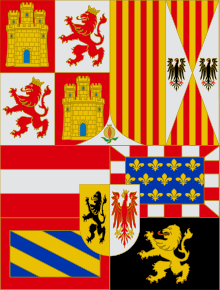 |
1668 - 1700 | Even though Portugal and its possessions were lost in 1640, the Spanish kings retained the use of the Portuguese arms as arms of pretence until 1668. |
| |
1700 - 1761 | The arms of Bourbon-Anjou House of Bourbon The House of Bourbon is a European royal house, a branch of the Capetian dynasty . Bourbon kings first ruled Navarre and France in the 16th century. By the 18th century, members of the Bourbon dynasty also held thrones in Spain, Naples, Sicily, and Parma... were added in 1700 when Phillip V Philip V of Spain Philip V was King of Spain from 15 November 1700 to 15 January 1724, when he abdicated in favor of his son Louis, and from 6 September 1724, when he assumed the throne again upon his son's death, to his death.Before his reign, Philip occupied an exalted place in the royal family of France as a... became king of Spain. He introduced changes in the royal arms Coat of arms of the King of Spain The blazoning of the coat of arms of the King of Spain is set out in Title II, Rule 1, of Spanish Royal Decree 1511 of 21 January 1977, by which the Rules for Flags, Standards, Guidons, Banners, and Badges were adopted.- Quartered shield :... of Spain Spain Spain , officially the Kingdom of Spain languages]] under the European Charter for Regional or Minority Languages. In each of these, Spain's official name is as follows:;;;;;;), is a country and member state of the European Union located in southwestern Europe on the Iberian Peninsula... . The king's new arms were designed by the French heraldist Clairambault in November 1700, and were as follows: Per fess: 1. per pale, quarterly Castile and Aragon, enté en point Granada, and per pale, Aragon and Aragon-Sicily; 2. Quarterly, Austria, Burgundy ancient, Burgundy modern and Brabant; enté en point, per pale Flanders and Tyrol. Overall an escutcheon Anjou Anjou Anjou is a former county , duchy and province centred on the city of Angers in the lower Loire Valley of western France. It corresponds largely to the present-day département of Maine-et-Loire... . |
.svg.png) |
1761 - 1868 1875 - 1931 |
In 1761 Charles III Charles III of Spain Charles III was the King of Spain and the Spanish Indies from 1759 to 1788. He was the eldest son of Philip V of Spain and his second wife, the Princess Elisabeth Farnese... modified the arms as follows: Quarterly of six (in three rows of two each): 1. per pale Aragon and Aragon-Sicily; 2. per pale Austria and Burgundy modern; 3. Farnese 4. Medici; 5. Burgundy ancient; 6. Brabant; enté en point per pale Flanders and Tyrol. Overall an escutcheon quarterly of Castile and Leon enté en point of Granada, overall Anjou. The royal arms were removed by the revolution of 1868 Glorious Revolution (Spain) The Glorious Revolution took place in Spain in 1868, resulting in the deposition of Queen Isabella II.An 1866 rebellion led by General Juan Prim and a revolt of the sergeants at San Gil barracks, in Madrid, sent a signal to Spanish liberals and republicans that there was serious unrest with the... . When the Bourbons were restored with Alfonso XII Alfonso XII of Spain Alfonso XII was king of Spain, reigning from 1874 to 1885, after a coup d'état restored the monarchy and ended the ephemeral First Spanish Republic.-Early life and paternity:Alfonso was the son of Queen Isabella II of Spain, and... , a decree (8 Jan 1875) recovered the coat of arms (and the banner of arms) as it stood until September 29, 1868 as personal arms. In 1930 Alfonso XIII Alfonso XIII of Spain Alfonso XIII was King of Spain from 1886 until 1931. His mother, Maria Christina of Austria, was appointed regent during his minority... , substituted the Aragon quarter with Jerusalem. The Spanish Monarch hasn't used a Banner of Arms since April 14, 1931, when the Second Spanish Republic Second Spanish Republic The Second Spanish Republic was the government of Spain between April 14 1931, and its destruction by a military rebellion, led by General Francisco Franco.... was proclaimed. |
| Royal Standard or Royal Flag | ||
| Standard | Dates | Details |
|---|---|---|
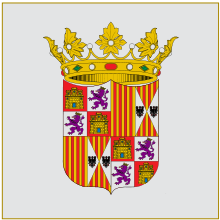 |
The Royal Standard or Royal Flag of the Catholic Monarchs was a white flag with the arms of Isabella I of Castile Isabella I of Castile Isabella I was Queen of Castile and León. She and her husband Ferdinand II of Aragon brought stability to both kingdoms that became the basis for the unification of Spain. Later the two laid the foundations for the political unification of Spain under their grandson, Charles V, Holy Roman Emperor... and Ferdinand II of Aragon Ferdinand II of Aragon Ferdinand the Catholic was King of Aragon , Sicily , Naples , Valencia, Sardinia, and Navarre, Count of Barcelona, jure uxoris King of Castile and then regent of that country also from 1508 to his death, in the name of... in the center with an open royal crown. |
|
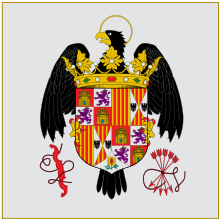 |
From 1492 the Catholic Monarchs's arms were borne by the eagle of Saint John John the Evangelist Saint John the Evangelist is the conventional name for the author of the Gospel of John... , sable, and the conquest of Granada was symbolized by the addition enté en point, a Pomegranate, of a quarter for Granada. |
|
 |
1668 - 1700 |
The Spanish Monarchs of the House of Habsburg used a crimson Crimson Crimson is a strong, bright, deep red color. It is originally the color of the dye produced from a scale insect, Kermes vermilio, but the name is now also used as a generic term for those slightly bluish-red colors that are between red and rose; besides crimson itself, these colors include... flag with the royal arms, crowned with a royal crown with three visible arches and the Order of the Golden Fleece Order of the Golden Fleece The Order of the Golden Fleece is an order of chivalry founded in Bruges by Philip III, Duke of Burgundy in 1430, to celebrate his marriage to the Portuguese princess Infanta Isabella of Portugal, daughter of King John I of Portugal. It evolved as one of the most prestigious orders in Europe... . |
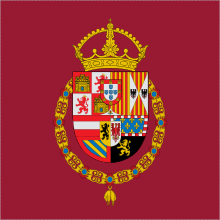 |
After the dynastic union Iberian Union The Iberian union was a political unit that governed all of the Iberian Peninsula south of the Pyrenees from 1580–1640, through a dynastic union between the monarchies of Portugal and Spain after the War of the Portuguese Succession... with Portugal in 1580 an escutcheon of Portugal was added on the honor point in the royal arms. |
|
 |
Philip V Philip V of Spain Philip V was King of Spain from 15 November 1700 to 15 January 1724, when he abdicated in favor of his son Louis, and from 6 September 1724, when he assumed the throne again upon his son's death, to his death.Before his reign, Philip occupied an exalted place in the royal family of France as a... introduced in the Royal Standard the changes of the royal arms Coat of arms of the King of Spain The blazoning of the coat of arms of the King of Spain is set out in Title II, Rule 1, of Spanish Royal Decree 1511 of 21 January 1977, by which the Rules for Flags, Standards, Guidons, Banners, and Badges were adopted.- Quartered shield :... of Spain Spain Spain , officially the Kingdom of Spain languages]] under the European Charter for Regional or Minority Languages. In each of these, Spain's official name is as follows:;;;;;;), is a country and member state of the European Union located in southwestern Europe on the Iberian Peninsula... . |
|
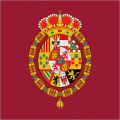 |
In 1761 Charles III Charles III of Spain Charles III was the King of Spain and the Spanish Indies from 1759 to 1788. He was the eldest son of Philip V of Spain and his second wife, the Princess Elisabeth Farnese... modified the royal arms, added the Farnese and Medici Medici The House of Medici or Famiglia de' Medici was a political dynasty, banking family and later royal house that first began to gather prominence under Cosimo de' Medici in the Republic of Florence during the late 14th century. The family originated in the Mugello region of the Tuscan countryside,... arms. |
|
 |
1875 - 1931 |
In 1838 the colour of the Royal Standard was modified (crimson to Purpure Purpure In heraldry, purpure is a tincture, more or less the equivalent of the colour "purple", and is one of the five main or most usually used colours... ). |
See also
- Coat of arms of the King of SpainCoat of arms of the King of SpainThe blazoning of the coat of arms of the King of Spain is set out in Title II, Rule 1, of Spanish Royal Decree 1511 of 21 January 1977, by which the Rules for Flags, Standards, Guidons, Banners, and Badges were adopted.- Quartered shield :...
- Coat of arms of the Prince of AsturiasCoat of arms of the Prince of AsturiasThe blazon of the coat of arms of the Prince of Asturias appears in Royal Decree 284 of 16 March 2001, whereby His Guidon and His Standard are created.QUARTERED SHIELD:...
- Heraldic flagHeraldic flagIn heraldry and vexillology, an heraldic flag is any of several types of flags, containing coats of arms, heraldic badges, or other devices, used for personal identification....
- Spanish monarchySpanish monarchyThe Monarchy of Spain, constitutionally referred to as The Crown and commonly referred to as the Spanish monarchy or Hispanic Monarchy, is a constitutional institution and an historic office of Spain...
Sources
- Spanish Royal Decree 1511/1977
- The flag in the Spanish Armada. Armada Española
- The Royal Standard of Spain. Flags of the World
- The Standard of the Prince of Asturias. Flags of the World

